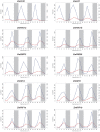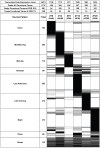Maize global transcriptomics reveals pervasive leaf diurnal rhythms but rhythms in developing ears are largely limited to the core oscillator
- PMID: 20886102
- PMCID: PMC2944807
- DOI: 10.1371/journal.pone.0012887
Maize global transcriptomics reveals pervasive leaf diurnal rhythms but rhythms in developing ears are largely limited to the core oscillator
Abstract
Background: Plant diurnal rhythms are vital environmental adaptations to coordinate internal physiological responses to alternating day-night cycles. A comprehensive view of diurnal biology has been lacking for maize (Zea mays), a major world crop.
Methodology: A photosynthetic tissue, the leaf, and a non-photosynthetic tissue, the developing ear, were sampled under natural field conditions. Genome-wide transcript profiling was conducted on a high-density 105 K Agilent microarray to investigate diurnal rhythms.
Conclusions: In both leaves and ears, the core oscillators were intact and diurnally cycling. Maize core oscillator genes are found to be largely conserved with their Arabidopsis counterparts. Diurnal gene regulation occurs in leaves, with some 23% of expressed transcripts exhibiting a diurnal cycling pattern. These transcripts can be assigned to over 1700 gene ontology functional terms, underscoring the pervasive impact of diurnal rhythms on plant biology. Considering the peak expression time for each diurnally regulated gene, and its corresponding functional assignment, most gene functions display temporal enrichment in the day, often with distinct patterns, such as dawn or midday preferred, indicating that there is a staged procession of biological events undulating with the diurnal cycle. Notably, many gene functions display a bimodal enrichment flanking the midday photosynthetic maximum, with an initial peak in mid-morning followed by another peak during the afternoon/evening. In contrast to leaves, in developing ears as few as 47 gene transcripts are diurnally regulated, and this set of transcripts includes primarily the core oscillators. In developing ears, which are largely shielded from light, the core oscillator therefore is intact with little outward effect on transcription.
Conflict of interest statement
Figures





Similar articles
-
Interspecific analysis of diurnal gene regulation in panicoid grasses identifies known and novel regulatory motifs.BMC Genomics. 2020 Jun 25;21(1):428. doi: 10.1186/s12864-020-06824-3. BMC Genomics. 2020. PMID: 32586356 Free PMC article.
-
Robust expression and association of ZmCCA1 with circadian rhythms in maize.Plant Cell Rep. 2011 Jul;30(7):1261-72. doi: 10.1007/s00299-011-1036-8. Epub 2011 Feb 16. Plant Cell Rep. 2011. PMID: 21327386
-
Global analysis of gene expression in maize leaves treated with low temperature. II. Combined effect of severe cold (8 °C) and circadian rhythm.Plant Mol Biol. 2017 Oct;95(3):279-302. doi: 10.1007/s11103-017-0651-3. Epub 2017 Aug 21. Plant Mol Biol. 2017. PMID: 28828699
-
Coordination of the maize transcriptome by a conserved circadian clock.BMC Plant Biol. 2010 Jun 24;10:126. doi: 10.1186/1471-2229-10-126. BMC Plant Biol. 2010. PMID: 20576144 Free PMC article.
-
Physiological significance of the plant circadian clock in natural field conditions.Plant Cell Environ. 2012 Oct;35(10):1729-41. doi: 10.1111/j.1365-3040.2012.02555.x. Epub 2012 Jul 18. Plant Cell Environ. 2012. PMID: 22681566 Review.
Cited by
-
Comparative transcriptome profiling of maize coleoptilar nodes during shoot-borne root initiation.Plant Physiol. 2013 Sep;163(1):419-30. doi: 10.1104/pp.113.221481. Epub 2013 Jul 10. Plant Physiol. 2013. PMID: 23843603 Free PMC article.
-
The Interplay between Carbon Availability and Growth in Different Zones of the Growing Maize Leaf.Plant Physiol. 2016 Oct;172(2):943-967. doi: 10.1104/pp.16.00994. Epub 2016 Aug 31. Plant Physiol. 2016. PMID: 27582314 Free PMC article.
-
ZmCCA1a on Chromosome 10 of Maize Delays Flowering of Arabidopsis thaliana.Front Plant Sci. 2020 Feb 20;11:78. doi: 10.3389/fpls.2020.00078. eCollection 2020. Front Plant Sci. 2020. PMID: 32153606 Free PMC article.
-
Overexpression of RING Domain E3 Ligase ZmXerico1 Confers Drought Tolerance through Regulation of ABA Homeostasis.Plant Physiol. 2017 Nov;175(3):1350-1369. doi: 10.1104/pp.17.01072. Epub 2017 Sep 12. Plant Physiol. 2017. PMID: 28899960 Free PMC article.
-
Expression conservation within the circadian clock of a monocot: natural variation at barley Ppd-H1 affects circadian expression of flowering time genes, but not clock orthologs.BMC Plant Biol. 2012 Jun 21;12:97. doi: 10.1186/1471-2229-12-97. BMC Plant Biol. 2012. PMID: 22720803 Free PMC article.
References
-
- Barak S, Tobin EM, Andronis C, Sugano S, Green RM. All in good time: the Arabidopsis circadian clock. Trends Plant Sci. 2000;5:517–522. - PubMed
-
- Harmer SL. The circadian system in higher plants. Annu Rev Plant Biol. 2009;60:357–377. - PubMed
-
- Dodd AN, Salathia N, Hall A, Kevei E, Toth R, et al. Plant circadian clocks increase photosynthesis, growth, survival, and competitive advantage. Science. 2005;309:630–633. - PubMed
-
- Mas P. Circadian clock function in Arabidopsis thaliana: time beyond transcription. Trends Cell Biol. 2008;18:273–281. - PubMed
Publication types
MeSH terms
Substances
LinkOut - more resources
Full Text Sources
Other Literature Sources
Molecular Biology Databases

